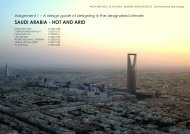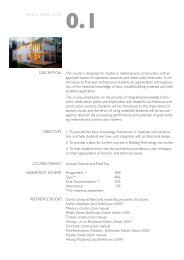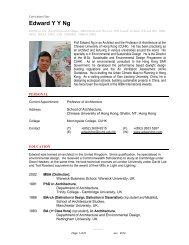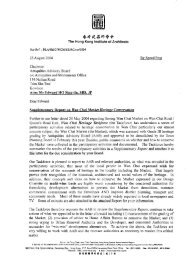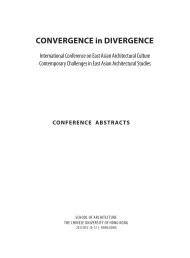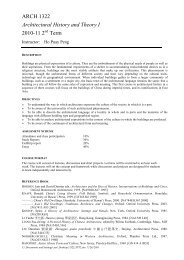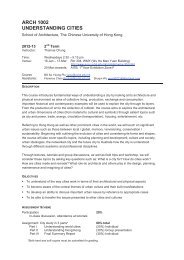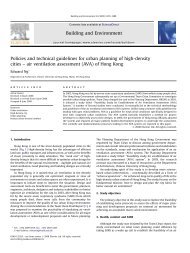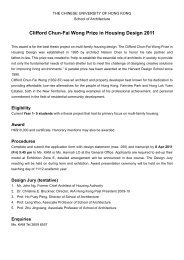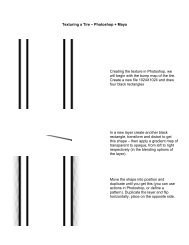Black Book - School of Architecture - The Chinese University of ...
Black Book - School of Architecture - The Chinese University of ...
Black Book - School of Architecture - The Chinese University of ...
- No tags were found...
You also want an ePaper? Increase the reach of your titles
YUMPU automatically turns print PDFs into web optimized ePapers that Google loves.
Studio U3DESIGN STUDIOuse | programmeProgramme and Use arch 2110bernard lim / joshua lau / esther lorenz / johnny wong<strong>The</strong> studio’s design approach is to link architectural space and human activity. Its method is toassemble archetypal activities (entry, gathering, worship, exchange, work, contemplation) anddevelop these into more complex narratives involving the experience <strong>of</strong> space + the uses <strong>of</strong> space.<strong>The</strong> Experience <strong>of</strong> SpaceMovement: kinesthetics - orientation and alignment - sequences - enclosure or release -18distance and proximity - hierarchies - expression through dynamics - path.Sensation: Optic - eye as register - perception <strong>of</strong> solid and void - the role and uses <strong>of</strong>19colour; Haptic (touch): the perception <strong>of</strong> textures, materiality, detail, weight. Auditory:significant parallel to overall perception, understanding distance, depth, materiality.Light: presence and modulation - effect <strong>of</strong> night and day - shadows - analogue to vision -transparency, translucency, and opacity.lenovo digital exhibition centre, hui wing hang keith<strong>The</strong> Uses <strong>of</strong> Spacehow space addresses functional, symbolic, and social needs.Symbolic Uses: every human activity, and every space for that activity, possesses anordinary as well as a symbolic dimension. If programme refers to the ordinary dimension,then occasion might refer symbolic aspects. Both designations are necessary; eachcontains the other. <strong>The</strong> task <strong>of</strong> design is to orchestrate programme in the service <strong>of</strong> theoccasion, and, in doing so, to reinvent their relationship - between the ordinary and thesymbolic, the everyday and the special, the mundane and the poetic. In architecturalterms this has been designated as servant and served space, ground and figure, fabric andmonument, function and expression, abstract space and event space (or social space).gallery <strong>of</strong> movie, sun yitan heatherpublic performance stage for different hierachies in yau ma tei, li chong yan tommyREQUIRED COURSEACTIVITYArchitectural History and <strong>The</strong>ory IIIarch 2321 thomas chungBuilding Technology II (Building Structure)arch 2411 bruce lonnmanComputer-Aided Architectural Designarch 2210 marc aurel schnabelDesign Computation3d modellingThis course examines the history and theory <strong>of</strong>modern architecture through significant works<strong>of</strong> the 20 th century. Modern buildings will besituated within the discourse on Modernism,and diverse ideas and designs through thedifferent movements and periods will be traced.<strong>The</strong> course focuses on how individual worksrelate to important manifestoes, critical writings,parallel developments in the arts, as well as themore general cultural, intellectual and historicalcircumstances <strong>of</strong> the time.<strong>The</strong> course is organized according to the fourbasic categories <strong>of</strong> structure described by Engel.Each type is studied to understand the physicalperformance characteristics based on action <strong>of</strong>forces and design parameters determined byeconomy, life safety and architectural context.Schematic, preliminary design exercises employingphysical behavior models, graphic statics formfindingand standard member selection designcharts provide experience in the selection andconfiguration <strong>of</strong> a few basic structural systems.Digital design media, methods <strong>of</strong>communications, and design computing inarchitecture are the core topics addressed in thiscourse. Digital instruments for drawing, drafting,image processing, 3D modelling and visualization,layout, (Internet-) publishing, and fabrication areintroduced through lectures covering theoreticalconcepts and practical skill building exercises.<strong>The</strong>se learning outcomes are applied andtransferred to problems and situations arisingfrom the design studio.Student use digital 3D modelling, renderingand animation to explore and communicateprogrammes within various spatial conditions.<strong>The</strong>y study 3D relationships between humans,activities and experiences that are simulated withdesign computation.



